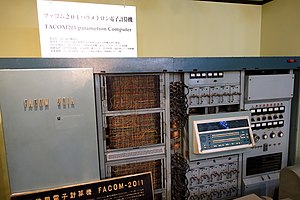
The parametron is a logic circuit element invented by Eiichi Goto in 1954. The parametron is essentially a resonant circuit with a nonlinear reactive element which oscillates at half the driving frequency. The oscillation can be made to represent a binary digit by the choice between two stationary phases π radians (180 degrees) apart.
Parametrons were used in early Japanese computers from 1954 through the early 1960s. A prototype parametron-based computer, the PC-1, was built at the University of Tokyo in 1958. Parametrons were used in early Japanese computers due to being reliable and inexpensive but were ultimately surpassed by transistors due to differences in speed.
See also
- Quantum flux parametron
- Eiichi Goto
- MUSASINO-1
- Magnetic amplifier
- Magnetic logic
- Parametric oscillator
References
- Information Processing Society of Japan - Parametron
- "Parametron". The history of computing project 17 March 2010. Retrieved 15 February 2011.
- U.S. Patent and Trademark Office - Class 307, Electrical Transmission or Interconnection Systems - Subclass 402, Parametrons
- Rojas, Rául; Hashagen, Ulf (2002). The First Computers: History and Architectures. Cambridge, Massachusetts: MIT Press. p. 429. ISBN 0-262-68137-4.
This computing article is a stub. You can help Misplaced Pages by expanding it. |